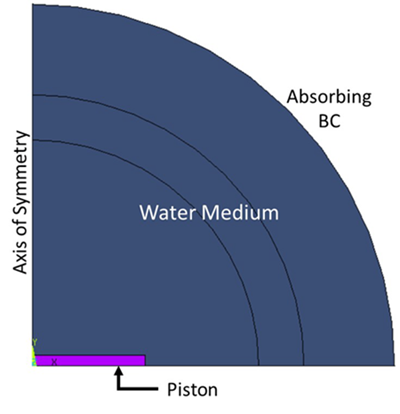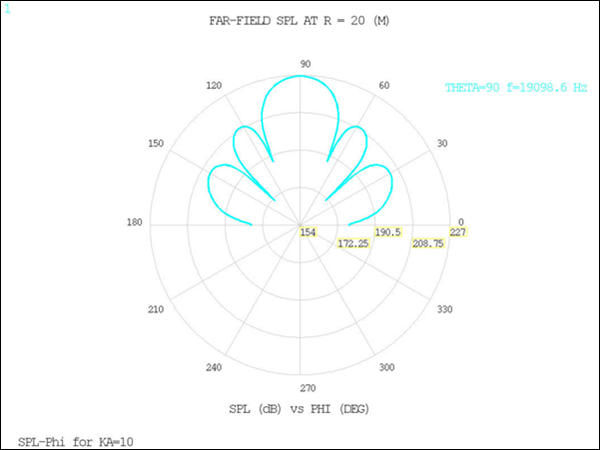This example uses the axially-symmetric acoustic element, FLUID244, to represent acoustic radiation from a circular piston in a water medium.
The figure below shows the two-dimensional model, including a piston structure and the fluid domain enclosed by radiation elements, FLUID129.
The Dirichlet boundary condition is applied to the piston surface for the displacement, and the equivalent source boundary condition (SF,,MXWF) is used for the radiation sources. The fluid-structure interface is applied on the surfaces between the structure and the fluid domain.
In reference [1], the theoretical acoustic pressure is given by:
where denotes the radius of the piston cylinder and
is wavelength.
represents the velocity of the piston.
The water mass density ()= 1000 kg/m3 and speed of sound
(c)= 1500 m/s.
The coupled harmonic analysis solves the fluid domain. After the computation of far-field propagation, PRFAR and PLFAR commands generate acoustic pressure and sound pressure level (SPL) output for different observer points.
/batch /prep7 KA=4 DIM_RAD = 0.125 K0=KA/DIM_RAD MAT_DENS = 1000 MAT_SONC = 1500 FREQUENCY = K0*MAT_SONC/(2*acos(-1)) WAVENUM = 2*acos(-1)*FREQUENCY/MAT_SONC WAVELENG = MAT_SONC/FREQUENCY DIM_BUFF = 0.3 DIM_MEAS = 0.4 un = 0.001 DIM_ESIZE = WAVELENG/12 ! ! Define Elements and Materials et,1,244,,0,1 ! 2nd-order Axisymmetric element et,3,129,2,,1 ! High order radiation element (Axisymmetric) et,2,183,,,1 r,1,20e-6 r,2,DIM_MEAS mp,dens,1,MAT_DENS mp,sonc,1,MAT_SONC mp,ex,2,1.44e11 mp,dens,2,7700 mp,nuxy,2,0.35 ! ! Generate Areas cyl4,0,0,0,0,DIM_RAD*2,90 rect,0,DIM_RAD,0,DIM_RAD/10 asba,1,2,,dele,keep cyl4,0,0,DIM_RAD*2,0,DIM_BUFF,90 cyl4,0,0,DIM_BUFF,0,DIM_MEAS,90 alls aglue,all alls ! ! Generate Mesh type,1 mat,1 !real,1 esize,DIM_ESIZE asel,u,,,2 amesh,all alls type,2 mat,2 asel,s,,,2 amesh,all alls nummgr,all alls csys,2 nsel,s,loc,x,DIM_MEAS type,3 mat,1 real,2 esize,DIM_ESIZE esurf alls ! ! Assign displacement csys,0 nsel,s,loc,x,0,DIM_RAD nsel,r,loc,y,0 d,all,uy,un alls ! ! MXWF BCs csys,2 nsel,s,loc,x,0,DIM_RAD*2 esln,s,1 nsel,s,loc,x,DIM_RAD*2 sf,all,mxwf alls csys,0 ! ! Solution /solu antype,harmic harfrq,1000,5000 nsub,4 kbc,1 solve finish ! /post1 csys,0 hfsym,0,,shb hfang,,0,360,0,90 /output set,1,1 prfar,pres,splc,0,90,9,90,90,1,20,, set,1,2, prfar,pres,splc,0,90,9,90,90,1,20,, set,1,4 prfar,pres,splc,0,90,9,90,90,1,20,, finish ! ! Postprocessing /post1 hfsym,0,,shb hfang,,0,360,0,90 plfar,pres,splc,0,90,9,90,90,1,20,2.e-5,,,,,all,2000,5000, finish ! ! Update KA KA=10 DIM_RAD = 0.125 K0=KA/DIM_RAD MAT_DENS = 1000 MAT_SONC = 1500 FREQUENCY = K0*MAT_SONC/(2*acos(-1)) ! ! New solution /solution antype,harmic harfrq,FREQUENCY nsub,1 kbc,1 solve finish ! /post1 hfsym,0,,shb hfang,,0,360,0,90 /output set,1,1 /title, SPL-Phi for KA=10 plfar,pres,splc,-5,5,100,0,10,100,0.0001,,,,,1,1,,,plxy plfar,pres,splp,0,180,180,90,90,1,20,2.e-5,,,,,all,2000,20000, finish
The sound pressure level at various angles is demonstrated in the figure below for 3 different frequencies (2000 Hz, 3000 Hz and 5000 Hz). The non-dimensional radial distance is 160.
Figure 13.16: Phi Angle vs. Sound Pressure Level Comparison of Theoretical and Mechanical APDL Results

To represent a similar computation to reference [1],
the value is set to 10. The driven far-field propagation outputs show good
agreement with the beam pattern in the reference.





